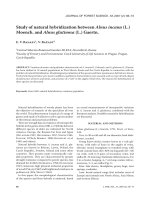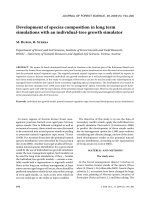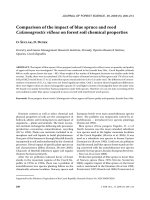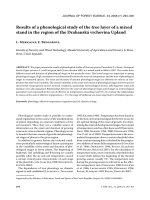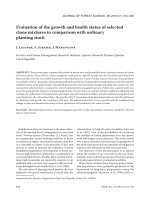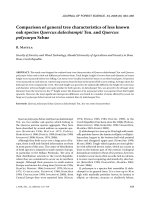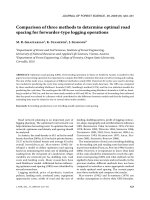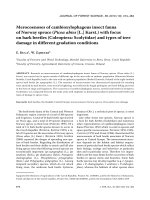Báo cáo lâm nghiệp: "Comparison of general tree characteristics of less known oak species Quercus dalechampii Ten. and Quercus polycarpa Schur" pot
Bạn đang xem bản rút gọn của tài liệu. Xem và tải ngay bản đầy đủ của tài liệu tại đây (236.96 KB, 7 trang )
J. FOR. SCI., 54, 2008 (8): 333–339 333
JOURNAL OF FOREST SCIENCE, 54, 2008 (8): 333–339
Quercus polycarpa Schur and Quercus dalechampii
Ten. are two similar oak species which belong to
the Quercus petraea species aggregate. ey have
been described by several authors as separate spe-
cies (S 1936; M 1971; P,
H 1986; D 1989; K 1990;
J 2000; M 1974, 2006).
Although they both occur over a large area of Eu-
rope, there is still only limited information on them
in most parts of this area. e centre of distribution
of both species is situated in south-eastern Europe,
in particular in the Balkan Peninsula. e area of
their distribution extends to the Czech Republic,
where they are considered to occur on its northern
margin. Although their presence in south-eastern
Europe was known for a long time (S 1936;
G, B 1966; J 1970; M
1971; C, P 1988; K
1990; C 1999; J 2000), from
Central Europe they were reported later (M
1974; P 1983, 1985; D 1989), in the
Czech Republic it has been since the 1980s (P,
H 1986; K 1990; Ú,
M 2001; K 2002).
Q. dalechampii is a tree up to 30 m high with mark-
edly petiolate leaves; the lamina is elliptic or elliptic-
lanceolate, largest in the bottom half with pointed
lobes and elongated upper part (K 1990;
M 2006). Tough-sided cupules are semi-globu-
lar with yellowish brown scales, which are coarse at
least on the bottom part of the exterior. Ecological
demands are similar to those of Q. petraea, however,
it tends to occur more often on soils rich in calcium,
it is more warm-requiring and stands dry sites bet-
ter (K 1990; Ú, M 2001;
M 2006).
Q. polycarpa is a species that resembles Q. dale-
champii in its general form. It is a tree up to 30 m
high with markedly petiolate leaves; its lamina is
elliptic or obovate, sinuous or shallowly lobate,
Comparison of general tree characteristics of less known
oak species Quercus dalechampii Ten. and Quercus
polycarpa Schur
R. M
Faculty of Forestry and Wood Technology, Mendel University of Agriculture and Forestry in Brno,
Brno, Czech Republic
ABSTRACT: is study was designed to evaluate basic tree characteristics of Quercus dalechampii Ten. and Quercus
polycarpa Schur and to find out differences between them. Total height, height of crown base and diameter at breast
height were measured before tree felling. Cut stems were visually checked for heart rot on their basal parts. Diameters
were measured on each stem in 1 meter long sections from the base to the point of life crown setting. Average values for
both species were compared by t-test. e total height was proved to be statistically different; the height of crown base
and diameter at breast height were quite similar for both species. Q. dalechampii Ten. was proved to be of larger stem
diameter from the tree foot to the 3
rd
height meter; the diameter of Q. polycarpa Schur was superior from that height
upwards. However, the most significant interspecies difference was found in a number of stems affected by wood-rot
fungi as Q. polycarpa Schur turned out to be less resistant than Q. dalechampii Ten.
Keywords: Quercus polycarpa Schur; Quercus dalechampii Ten.; dry rot; stem characteristics
334 J. FOR. SCI., 54, 2008 (8): 333–339
tough (K 1990; M 2006). Cupules are
semi-globular with tough sides, with coarse scales
on the whole exterior. e scales are widely ovate
with pointed apex, pilose, bald on the back, reddish
brown. In general, it is considered to be a dry-tol-
erant species which tends to grow both on poor
acid and basic soils (K 1990; Ú,
M 2001; M 2006).
Although several species keys to both species ex-
ist (M 1974, 2006; D 1989; K
1990; P 1998; K 2002), their distinction
is still considered to be difficult. Leaf characteristics
are very variable (C 1995), so mature acorn
cupules are usually needed for exact determination.
However, a high number of cupules usually occurs
only once in several years (O, K
1989), so they are often difficult to find. Even when
they occur, they become ripe in the autumn, which
is mostly the only time of the year when oak trees
of these species can be reliably identified. Another
problem is frequent introgressive hybridization
within all species of the Quercus petraea aggregate
(K, Ú 2000) which often causes
that the key species characteristics are not well de-
veloped and cannot be clearly assigned to one spe-
cies. e difficult identification and relatively high
occurrence of hybridized individuals mean that in
the Czech Republic both oak species are not usually
distinguished from each other and from Q. petraea
(Mattuschka) Liebl. and are simply described as
Quercus petraea sensu lato.
Several studies on taxonomy and ecology of
Q. polycarpa
or Q. dalechampii have been published
so far (P, H 1986; C
1999; P 1999, 2001), however, only a few in
the Czech Republic (C 1995; M 2004).
e main goal of this study was to evaluate basic tree
features which are important from the forestry as-
pects. I focused especially on stem characteristics in
order to find out whether there were any differences
in this respect. Besides the basic characteristics
such as total height, height of live crown base and
diameter at breast height I measured stem diameters
minutely in order to describe differences in a general
stem form.
Attention was also paid to wood decay as tree
cutting allowed me to evaluate the presence of dis-
coloured wood in stems of recently felled studied
trees. e decay process in a living tree is a complex
chain of environmentally influenced events driven
by stress, competition and disturbance (R,
B 1986). ere are two basic groups of wood-
inhabiting fungi. e first group is represented by
saprotrophic fungi which utilize dead wood as a food
base for growth and reproduction, the second one
by those which attack the wood of standing living
trees. Some fungi of the latter group can invade
and kill living sapwood causing death to living
trees (D et al. 2007), others live in the heartwood
of living hosts, and these are commonly referred
to as heart-rot fungi (S, L 2005). e
heart rot fungi are usually restricted to a non-living
part of the tree, but they cause major volume losses
of saw timber (D et al. 2007). In addition, trees
infected by heart-rot fungi become weakened struc-
turally (T et al. 2007) and are easily broken
due to windthrow (H 1995; L, L-
1999). However, decay fungi are important
ecologically as they play an important role in gap
formation and so facilitate an uneven-aged stand
structure (L, L 1999). Some oak spe-
cies have been found susceptible to diseases caused
by heart rot fungi which may be causal agents of
their death (S, B 1990; F et
al. 2002; M et al. 2005). e most visible
symptom is discoloration of heartwood, which
means that attacked wood differs in colour intensity
from normal wood (P 2007).
Both species, Q. dalechampii and Q. polycarpa,
could be very perspective for forestry due to their
ability to stand dry hot summers and cold winters as
they do in south-eastern Europe. is feature may be
important especially in future as global warming is
likely to bring about significant changes in climate
conditions of forest ecosystems all around Europe.
MATERIALS AND METHODS
e study was carried out in two forest stands
situated close to the Hádecká planinka protected
area. e forest stands were chosen due to natural
occurrence of researched species Q. dalechampii and
Q. polycarpa, which had been reported from there
before (M 2004). In addition, both oaks spe-
cies strongly dominated the studied forests stands.
Moreover, a tree felling was under way there at that
time due to which a part of research could be carried
out on lying trees.
e forest stands were coppice converted into
high stands on gentle slopes of south western aspect.
e parent rock of the sites consisted of limestone;
the soil was classified as rendzina. Within Zlatník’s
groups of geobiocene types (B, L 1999)
the sites belong to the Ligustri – Querceta humilia
superiora group of geobiocene types (2 BD 2).
I estimated an approximate age of the forest be-
tween 100 and 110 years (by calculating the growth
rings on cut trees). Q. polycarpa represented 49.0%,
J. FOR. SCI., 54, 2008 (8): 333–339 335
Q. dalechampii 40.5%, Q. petraea (Mattuschka)
Liebl. 3.0% and the hybrid Q. barnovae Georg. Et.
Dobrescu (Q. dalechampii Ten. × Q. polycarpa
Schur) 2.0% of tree species in the main storey. ey
were rarely accompanied by Tilia cordata P. Miller,
Sorbus torminalis (L.) Crantz and Acer campestre L.
e well-developed shrub layer was rich in species.
Among others, Cornus mas L. and Ligustrum vulgare
L. were the most frequent. Carex pilosa Scop., Carex
digitata L., Poa nemoralis L., Vincetoxicum hirundi-
naria Med., Galium sylvaticum L., Hepatica nobilis
Schreber, Asarum europaeum L., Stellaria holostea
L. and Origanum vulgare L. were the most dominant
species in the herb layer.
In total, 48 trees of Q. polycarpa and 48 trees of
Q. dalechampii were measured. Only mature trees
reaching the main storey of the forest canopy were
used for measurements. Suppressed trees were
excluded from the study. Other oak species repre-
sented by trees of Q. petraea and of the hybrid Q.
barnovae were not taken into account.
Total height, diameter at breast height and height
of crown base were measured on all studied trees.
e height measurements were carried out with
SILVA ClinoMaster (accuracy ± 0.25°), the diameter
with diameter tape (accuracy 0.001 m). After tree
felling, samples of leaves and cupules for species
identification were easily taken away from upper
insolated parts of crowns of the previously measured
trees. After that, diameters at each 1 m of length of
each stem were measured. e first diameter was
measured at the length of 1 m from a tree foot, the
second one at the length of 2 m, the third one at the
length of 3 m etc. In the end, the same trees were
examined for wood decay. Each trunk was visually
checked in the part of the cut whether there was any
discoloured wood or not. If there was, the tree was
considered as affected by heart rot and classified as
attacked.
Collected data were processed with statistical soft-
ware Statistica 6.0. Means and standard deviations
were calculated for each characteristic within each
species. Normality of data distribution was tested by
Shapiro-Wilk W test. Since the value W did not prove
significant in any characteristics (P > 0.05 so the data
were normally distributed), t-test for independent
samples was carried out to evaluate statistical sig-
nificance of differences between both species within
each variable. For an interspecies comparison of
numbers of attacked trees I carried out Cochrane
Q
test. In both tests the limit of statistical significance
was set at P < 0.05.
RESULTS AND DISCUSSION
e average total height of Q. dalechampii was
19.3 m; the standard deviation was 0.64 m. The
height of Q. polycarpa was 20.4 m on average; the
value of standard deviation was 0.71 m (Fig. 1). T-test
proved the difference to be statistically significant
(t = –3.9613, P < 0.0007), however, it was not large
(Table 1).
Table 1. Average values of height, height of crown base
(HCB) and diameter at breast height (d
1.3
) and their
comparison. Statistically significant values are highlighted
by bold letters
Characteristics
Average Sd
dal pol dal pol
Height (m) 19.3 20.4 0.64 0.71
HCB (m) 11.8 12.4 0.96 1.42
d
1.3
(cm) 33.4 32.3 2.24 1.56
Average difference in the height of crown base
was similar to the values of total tree heights. e
0
5
10
15
20
25
Q. dalechampii Q. polycarpa
Total height (m)
0
5
10
15
Q. dalechampii Q. polycarpa
HCB (m)
Fig. 1. Average total height of measured trees of both studied
species
Fig. 2. Average height of the live crown base of both studied
species
Q. dalechampii Q. polycarpa Q. dalechampii Q. polycarpa
336 J. FOR. SCI., 54, 2008 (8): 333–339
average height of crown setting was 11.8 m for
Q. dalechampii
and 12.4 m for Q. polycarpa. Stand-
ard deviations were 0.96 m for Q. dalechampii and
1.42 m for Q. polycarpa (Fig. 2). Although there was
a difference of 0.6 m on average, it turn out to be
statistically insignificant (t = –1.2577, P = 0.2216)
(Table 1).
Interesting results were obtained from measured
diameters. Diameters at the breast height of both oak
species did not prove statistically different. Q. dale-
champii had an average diameter of 33.4 cm, which
was only a little more than the breast-height diam-
eter of Q. polycarpa, which was 32.3 cm on average
(t = 1.3999, P = 0.1755) (Table 1). Nevertheless, when
diameters of 1 meter stem sections were measured, it
was found out that from the base to the crown base,
diameters of the first, second and third section were
greater for Q. dalechampii trees, whereas from the
fourth meter upwards diameters of Q. polycarpa
were superior to those of Q. dalechampii (Fig. 3).
ese differences even increased with an increasing
height. When the difference was about 0.1 cm in the
fourth meter section, it reached more than 2.0 cm
in the 10
th
and 11
th
meters. However, statistically
significant differences were found only in the first
length meter (t = –2.7928, P = 0.0076) and in the
last two sections (10
th
: t = 3.0331, P = 0.004; 11
th
:
t = 3.2222,
P = 0.0023) (Table 2).
A large interspecies difference was found in the
number of stems affected by heart rot (Q = 21.00,
P < 0.000005). Discoloured wood was found in
13 percent of Q. dalechampii individuals and the rest
of them, 87 percent, did not show any signs of fungus
infection. In contrast, 57 percent of Q. polycarpa
trees had their stems affected by heart rot fungi and
only 43 percent of them had no signs of discolora-
tion (Fig. 4). Fistulina hepatica (Schaeff.) With. and
Inonotus sp. were recognized as the most frequent
fungi species which occurred in the trunks.
Average values of total height document that
Q. polycarpa
is slightly higher than Q. dalechampii.
e height of the crown base of Q. polycarpa can also
be considered higher. Q. dalechampii turned out to
be of larger stem diameter at the height up to 3 m; the
Table 2. Average diameter of 1 m stem sections and their comparison. Statistically significant values are highlighted by
bold letters
Height section
Average diameter (cm) Sd
t P
pol dal pol dal
1 32.5 34.0 1.38 2.32 –2.7928 0.0076
2 31.9 32.5 1.83 2.17 –1.1403 0.2601
3 30.8 31.4 1.96 1.93 –1.0472 0.3005
4 30.1 30.1 1.06 1.56 0.1781 0.8595
5 29.5 28.9 0.87 1.74 1.4642 0.1500
6 28.7 27.9 1.91 1.60 1.5694 0.1234
7 27.8 26.9 1.97 2.50 1.3408 0.1866
8 27.0 26.1 1.72 2.48 1.5130 0.1371
9 25.2 23.9 2.04 2.48 1.9603 0.0560
10 24.2 22.4 2.18 1.93 3.0331 0.0040
11 23.1 20.9 1.98 2.53 3.2222 0.0023
17
22
27
32
37
0 1 2 3 4 5 6 7 8 9 10 11 12
Stem length (m)
Stem diameter (cm)
pol dal
Fig. 3. Stem diameters related to the
height of both species. The symbol
pol stands for Q. polycarpa and dal for
Q. dalechampii
J. FOR. SCI., 54, 2008 (8): 333–339 337
diameter of Q. polycarpa is greater from the fourth
meter upwards. All these findings show that the stem
of Q. polycarpa is slightly longer and wider than that
of Q. dalechampii. It indicates that its stems attain
a slightly larger volume and thus a larger volume of
wood. e values of the diameters of 1 meter stem
sections also show that stems of Q. dalechampii ta-
per off slightly more than Q. polycarpa stems which
tend to be more full-boled.
In both species high numbers of trees affected by
heart rot turned out to be a negative and important
factor that significantly decreases the tree stability
and wood quality of studied stands. A reason for this
might be that these stands are coppices converted
into high stands which tend to be more susceptible
to decline-inducing factors are often related to oak
decline (T et al. 2002). Overaged oak trees in
coppice forests have lower ability to conduct water,
assimilate carbon and grow, which causes that these
trees might be more susceptible to stress factors
such as summer drought (C et al. 2005).
F (1998) assumes that the combination of
regional climate and local overaging factors may
explain most variability in oak decline processes in
forests of Central Europe. Oak decline has occurred
in large areas of oak forests across Europe over the
last several decades (O, P 1987; S-
, U 1998; B, H
2003). Fungal diseases in combination with abiotic
stress are considered to be among the main causal
agents (H, D 1999; J et al. 2000;
T et al. 2002). However, there is a difference
in resistance to wood-decay fungi between the stud-
ied oak species. Individuals of Q. polycarpa suffer
from heart rot very much; the majority of them are
affected so the amount of saw timber and its qual-
ity are considerably reduced. In addition, the heart
rot of basal stem parts weakens their mechanical
strength, which causes that windthrows and break-
ages occur significantly as described by several
authors (H 1995; L, L 1999;
T et al. 2007). On the contrary, the majority of
Q. dalechampii stems are not affected by wood-de-
cay fungi, which means that in general they are much
less susceptible to mechanical damage and have the
wood of comparatively better quality.
e results suggest that decay fungi play an im-
portant role in removing Q. polycarpa from the
canopy of the studied sites. erefore, if there were
no influence of human activity, the oak composition
of studied stands would probably change. At present,
Q. polycarpa is the most common oak, however, its
representation would decline due to its higher mor-
tality rate while the representation of Q. dalechampii
might remain unchanged or even increase. This
should be taken into account in forest management
as Q. dalechampii might also be more resistant to
general oak decline. Q. polycarpa could probably
be more resistant in different habitat conditions
where it would be able to protect itself from fungal
diseases. Due to its slightly better growth it might be
an advantageous species. Preferring Q. dalechampii
in thermophilic woods on limy soils can improve
timber production with consequent positive eco-
nomic effect as well as maintain ecological stability
of oak stands without negative impact on ecological
functions of such forests.
CONCLUSIONS
Q. dalechampii in comparison with Q. polycarpa
was proved to be more suitable for growing in natural
conditions of researched sites where it yields wood
of better quality and its stands are more stable there.
Q. polycarpa appears to be only slightly better grow-
ing but much less resistant to decay fungi.
All these findings show that both species differ
and good knowledge of their properties can give us
a possibility of benefiting from them in many ways.
Especially nowadays when facing global warming
both species might play an important role in forest
ecosystems and might be commonly used in the
forestry.
R ef er en c e s
BALCI Y., HALMSCHLAGER E., 2003. Incidence of Phyto-
phthora species in oak forests in Austria and their pos-
sible involvement in oak decline. Forest Pathology, 33:
157–174.
BUČEK A., LACINA J., 1999. Geobiocenologie II. Brno,
MZLU: 240.
CHYTRÁ M., 1995. Studie variability Quercus petraea agg.
Brno, Masarykova univerzita : 65.
Fig. 4. Representation of trees affected by heart rot
13
57
0
20
40
60
Q. dalechampii Q. polycarpa
(%)
Q. dalechampii Q. polycarpa
57
338 J. FOR. SCI., 54, 2008 (8): 333–339
CORCUERA L., CAMARERO1 J.J., SISÓ S., GIL-PELEGRÍN
E., 2005. Radial-growth and wood-anatomical changes in
overaged Quercus pyrenaica coppice stands: functional
responses in a new Mediterranean landscape. Trees – Struc-
ture and Function, 20: 91–98.
CVJETICANIN R., 1999. Taksonomija i cenoekologija bal-
kanskog hrasta kitnjaka (Quercus dalechampii Ten.) na
serpentinama centralne i zapadne Srbije. Belgrade, Belgrade
University: 310.
CVJETICANIN R., PAUNOVIĆ P., 1988. Prilog poznavanju
hrastova Fruške Gore. Glasnik Šumarskog fakulteta, 70:
59–66.
DAI Y.C., CUI B.K., YUAN H.S., LI B.D., 2007. Pathogenic
wood-decaying fungi in China. Forest Pathology, 37:
105–120.
DOSTÁL J., 1989. Nová květena ČSSR 1. Praha, Academia:
1563.
FULÉ P.Z., COVINGTON W.W., MOORE M.M., HEINLEIN
T.A., WALTZ A.E.M., 2002. Natural variability in forests
of the Grand Canyon, USA. Journal of Biogeography, 29:
31–47.
FÜHRER E., 1998. Oak decline in Central Europe: a synopsis
of hypotheses. In: McMANUS M.L., LIEBHOLD A.M.
(eds), Proceedings: Population Dynamics, Impacts, and
Integrated Management of Forest Defoliating Insects.
USDA Forestry Service, General Technical Report NE-
247: 7–24.
HANSEN E.M., DELATOUR C., 1999. Phytophthora species
in oak forests of north-east France. Annals of Forest Sci-
ence, 56: 539–547.
HENNON P.E., 1995. Are heart rot fungi major factors of
disturbance in gap-dynamic forests? Northwest Science,
69: 284–293.
JOSIPOVIČ M., 1970. Flora SR Srbije. Beograd: 77−98.
JOVANOVIČ B., 2000. Dendrologija. Belgrade, Belgrade
University: 567.
JUNG T., BLASCHKE H., OßWALD W., 2000. Involvement
of soilborne Phytophthora species in Central European oak
decline and the effect of site factors on the disease. Plant
Pathology, 49: 706–718.
KOBLÍŽEK J., 1990. Quercus L. In: HEJNÝ S., SLAVÍK B.
(eds), Květena ČR 2. Praha, Academia: 21–35.
KOBLÍŽEK J., ÚRADNÍČEK L., 2000. Příspěvek k rozlišování
a ekologii původních druhů rodu Quercus L. In: Rozlišování
dubů a možnosti udržení druhové čistoty v lesních porostech.
Roztoky u Křivoklátu, Česká lesnická společnost: 1−5.
KUBÁT K., 2002. Klíč ke květeně České republiky. Praha,
Academia.
LEWIS K.J., LINDGREN B.S., 1999. Picea glauca × engelman-
nii and Abies lasiocarpa in sub-boreal forests of central
British Columbia. Forest Ecology and Management, 123:
135–143.
MAGIC D., 1974. Poznávame ďalšie druhy dubov v našich
lesoch. Les, 30: 244–252.
MAGIC D., 2006. Quercus L. In: GOLIÁŠOVÁ K.,
MICHÁLKOVÁ N. (eds), Flóra Slovenska V/3. Bratislava,
Veda: 342.
MALONEY P.E., LYNCH S.C., KANE S.F., JENSEN C.E.,
RIZZO D.M., 2005. Establishment of an emerging gener-
alist pathogen in redwood forest communities. Journal of
Ecology, 93: 899–905.
MATULA R., 2004. Comparison of stem characteristics of
oak species Q. dalechampii Ten. and Q. polycarpa Schur.
In: BUCHTA I. et al., Contemporary state and develop-
ment trends of forests in cultural landscape. Brno, MZLU:
89–91.
MATYAS V., 1971. Short taxonomic review of the oaks of
Hungary. Erdészeti Kutatàsok Budapest, 67: 55–68.
OLEKSYN J., PRZYBYL K., 1987. Oak decline in the Soviet
Union – scale and hypotheses. European Journal of Forest
Pathology, 17: 321–336.
OSTROLUCKÁ M., KRIŽO M., 1989. Biológia samčích
reprodukčných orgánov druhov rodu Quercus L. Bratislava,
Veda: 135.
POŽGAJ J., 1983. Duby našich lesov. Živa, 4: 126−128.
POŽGAJ J., 1985. Poznávanie autochtónnych dubov Sloven-
ska. Lesnícky časopis, 31: 3–7.
POŽGAJ J., 1999. Quercus polycarpa Schur (polycarpic oak)
in Slovakia. Folia Oecologica, 26: 21−32.
POŽGAJ J., 2001. Quercus dalechampii Ten. in Slovakia. Folia
Oecologica, 28: 7−21.
POŽGAJ R., 1998. Identification of Slovak oaks by their bark.
Acta Facultatis Xylologiae, 39: 25−32.
POŽGAJ J., HORVÁTHOVÁ J., 1986. Variabilita a ekológia
druhov rodu Quercus L. na Slovensku. Bratislava, Veda:
151.
PRZYBYL K., 2007. Fungi and minerals occurring in heart-
wood discolorations in Quercus robur trees. Acta Societatis
Botanicorum Poloniae, 76: 55–60.
RAYNER A.D.M., BODDY L., 1986. Population structure and
the infection biology of wood-decay fungi in living trees.
Advances in Plant Pathology, 5: 119–160.
SCHWARZ O., 1936. Monographie der Eichen Europas und
des Mittelmeergebietes. Dahlem bei Berlin: 1–160.
SINCLAIR W., LYON H.H., JOHNSON W.T., 1987. Diseases of
Trees and Shrubs. Ithaca, Cornell University Press: 574.
SIWECKI R., UFNALSKI K., 1998. Review of oak stand de-
cline with special reference to the role of drought in Poland.
European Journal of Forest Pathology, 28: 99–112.
SWIECKI J.T., BERNHARDT E., 1990. A delicate balance:
Impacts of diseases and insects on the health of California
oaks. Fremontia, 18: 58–63.
TERHO M., HANTULA J., HALLAKSELA A.M., 2007.
Occurrence and decay patterns of common wood-decay
J. FOR. SCI., 54, 2008 (8): 333–339 339
fungi in hazardous trees felled in the Helsinki City. Forest
Pathology, 37: 420–432.
THOMAS F.M., BLANK R., HARTMANN G., 2002. Abiotic
and biotic causes and their interaction as causes of oak
decline in Central Europe. Forest Pathology, 32: 277–307.
ÚRADNÍČEK L., MADĚRA P., 2001. Dřeviny České republiky.
Písek, Matice lesnická: 333.
Received for publication February 1, 2008
Accepted after corrections June 5, 2008
Corresponding author:
Ing. R M, Mendelova zemědělská a lesnická univerzita v Brně, Lesnická a dřevařská fakulta,
Lesnická 37, 613 00 Brno, Česká republika
tel.: + 420 545 134 058, e-mail:
Srovnání stromových charakteristik méně znamých druhů dubu
Quercus dalechampii Ten. a Quercus polycarpa Schur
ABSTRAKT: Studie se zabývá základními lesnickými charakteristikami dubů Quercus dalechampii Ten. a Quercus
polycarpa Schur a rozdíly mezi nimi. Byla u nich měřena výčetní tloušťka, celková výška a výška nasazení koruny. Na
pokácených kmenech bylo rovněž sledováno napadení dřevokaznými houbami. Zvláštní pozornost byla věnována
vlastnostem kmene, kde byla měřena tloušťka kmene od báze po nasazení koruny po jednom metru. Z hodnocených
vlastností se jako statisticky významné ukázaly rozdíly v celkové výšce; ve výčetní tloušťce a ve výšce nasazení koruny
nebyl nalezen významný rozdíl. Ukázalo se, že Q. dalechampii má průměr větší od báze kmene do výšky 3 m, naopak
od této výšky nahoru má kmen silnější Q. polycarpa. U Q. dalechampii bylo nalezeno výrazně méně jedinců napade-
ných dřevokaznými houbami než u Q. polycarpa, což se ukázalo být jako významný rozdíl mezi oběma taxony.
Klíčová slova: dub žlutavý; dub mnohoplodý; hniloba kmene; charakteristiky kmene
